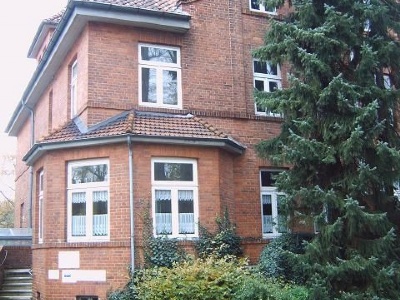Lüneburg
In March and April 1945, most of the nazi top bigwigs knew that the war was lost. The exceptions were Hitler and Goebbels who hoped and believed that the coalition between the western allies and the Soviet Union would break down and bring the war into a favourable direction for the Nazis. SS chief Heinrich Himmler who was in northern Germany belonged to the former. and did not believe in Hitler’s reasoning that the coalition against Germany would break down. Himmler made his own plans and tried to enter into negotiations with the Western allies.
Himmler initiated a dialogue with Swedish Red Cross vice president Folke Bernadotte. The idea from Himmler was to present a peace proposal through Bernadotte and the Swedish government to General Eisenhower. Himmler wanted a peace treaty only with the western powers and not with Soviet union. Himmler and Bernadotte met the night between April 23 and 24 to discuss the possibilities of peace negotiations. Folke Bernadotte was not a political diplomat, however, and had no political mandate to act as a mediator. Moreover, the Western allies were not at all interested in Himmler’s proposal for a separate peace and the proposal never got serious.
It seemed that Himmler really believed that the Western allies would accept him as a legitimate leader of Germany. Himmler seemed to believe that there was a place for him as a political leader in a future Germany. To the Western allies, Himmler was a war criminal to be brought to justice. When Hitler found out about Himmler’s peace proposal, he expelled Himmler from the party and took away all his powers. When Himmler realized that his peace offer was not successful and that he was in danger of being brought to justice, he tried to escape. He got rid of his uniform, shaved off his moustache, wear an eye patch, obtained forged documents and called himself Heinrich Hitzinger.
But Himmler did not get far, on May 22 he was arrested by a British patrol outside Bremen and taken to Lüneburg, about thirty kilometers south of Hamburg. On May 23, he was taken to a British army quarter on Uelzener Strasse for questioning and after a short while confessed he was Heinrich Himmler. But shortly afterwards, for an unattended moment, he bit a cyanide capsule he had hidden in his mouth. Despite several attempts to resuscitate him, Himmler was dead. He was buried in an unknown location in a nature reserve outside Lüneburg.
Current status: Preserved (2007).
Address: Uelzener Strasse 31, 21335 Lüneburg.
Get there: Car.
Follow up in books: Longerich, Peter: Himmler: A Biography (2009).

In 2007 there was a private firm in the house. There is a conspiracy theory that Himmler would have been murdered by British agents during the interrogation. The reason would have been that Himmler was in possession of information about his possible contacts with the British in connection with his peace proposals. Information if been made public at a possible trial could be harmful to the British. But it is likely that Himmler committed suicide because he was fully aware of the punishment that awaited him. But one thing the British understood was not to reveal the place where he was buried, therefore, the funeral was surrounded by a great secrecy with a few involved and those papers with information about the grave’s position are still classified.